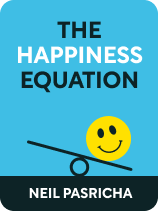

This article is an excerpt from the Shortform book guide to "The Happiness Equation" by Neil Pasricha. Shortform has the world's best summaries and analyses of books you should be reading.
Like this article? Sign up for a free trial here .
What is the key to happiness? Can you train yourself to be happier?
The first key to feeling happier is training yourself to think more positively and feel happy regardless of your circumstances. In his book The Happiness Equation, Neil Pasricha suggests training yourself to be happier with six methods: 1) get active, 2) do good deeds, 3) switch off, 4) engage fully, 5) practice meditation, and 6) be thankful.
Here’s how you can stop external circumstances from dictating your mood and train yourself to be happier.
Train Yourself to Think Positive Thoughts
Basing happiness on circumstances being a certain way prevents you from feeling happy. Life’s full of problems and challenges—circumstances are rarely exactly how you want them to be, no matter how hard you try to force them into place. Therefore, there’s always an excuse not to be happy. But unwanted experiences aren’t to blame for your unhappiness—your negative thoughts about them are. Therefore, the first key to happiness is to train yourself to think positive thoughts no matter the circumstances in your life.
Here’s how you can train yourself to be happier:
Method #1: Get Active
30 minutes of exercise three times a week increases your ability to feel positive and reduces symptoms of stress, anxiety, and depression.
(Shortform note: Neurobiology research shows that in addition to improving your physical health, regular exercise releases the neurochemicals GABA, serotonin, BDNF, and endocannabinoids. These chemicals increase happiness by stimulating cognition (learning and memory), regulating emotions, and enhancing self-esteem. To use this method effectively, set a realistic exercise goal that fits with your daily schedule. You’re more likely to stick to an easily achievable exercise routine—resulting in positive feelings of accomplishment and improved brain chemistry.)
Method #2: Do Good Deeds
Deliberately performing spontaneous acts of kindness makes you feel good about yourself. An added benefit is that others show more appreciation to you too.
(Shortform note: Scientific research confirms that practicing kindness does make you happier. When you give (knowledge, assistance, time, or money) with the intention of helping others, you activate the same parts of your brain that are stimulated by pleasurable activities such as eating good food or having great sex. However, in How to Stop Worrying and Start Living, Dale Carnegie warns that practicing kindness with the intention to receive appreciation creates disappointment if you don’t receive it—thus, making you unhappy. Therefore, release expectations of gratitude or appreciation to fully benefit from your good deeds.)
Method #3: Switch Off
Taking time off from your to-do lists and distractions allows your brain to rest and recharge—giving you more energy to maintain a positive focus.
(Shortform note: Research into ultradian rhythms clarifies how taking time off from obligations and distractions improves your focus. When your mind’s busy on a task, your brain and body burn sources of energy such as oxygen and glucose. This process creates metabolic waste that accumulates in your system and leads to feelings of fatigue, stress, and irritability—impeding your ability to focus. Taking 20-minute breaks every 90 minutes allows your body to flush this waste out of your system, restore your energy sources, and revive your focus.)
Method #4: Engage Fully
Being fully engaged in your tasks and activities deters distractions because your brain is occupied by accessing all of your knowledge and skills. This makes you feel more positive and also increases your productivity.
(Shortform note: When you only give tasks partial focus—by multitasking or giving in to distractions—you interrupt your brain from accessing and applying information stored in your mind. This slows down your progress and makes your task feel laborious. On the other hand, intense, full focus helps your brain effortlessly sift through and apply information stored in your brain, speeds up your progress, and makes your task feel enjoyable. Intense focus also limits activity in the prefrontal cortex, the part of your brain that’s associated with self-monitoring, insecurities, and worries—thus quieting the source of negative, unhappy thoughts.)
Method #5: Practice Meditation
Adopting a daily mindfulness ritual such as meditation builds your self-awareness, encourages feelings of compassion towards yourself and others, and decreases feelings of stress and anxiety.
(Shortform note: Mental health practitioners confirm that practicing mindfulness increases self-awareness, encourages positive thoughts about yourself, your circumstances, and others, and improves your mental well-being. Consequently, mindfulness practices also help you manage the symptoms of many stress-related health issues such as high blood pressure or tension headaches. In Mindfulness in Plain English, Bhante Gunaratana recommends establishing a schedule to turn your mindfulness practice into a habit. Begin by setting aside 10 to 20 minutes each morning or evening, lengthening your time as you get more comfortable with the process.)
Method #6: Be Thankful
Each day, make a small list of things to be grateful for. Taking time to write about experiences you’re thankful for keeps you focused on what you like about your life and how lucky you are.(Shortform note: Though the mood-boosting benefits of gratitude are well-known, it can be difficult to practice focusing on what’s going well, especially when things aren’t. Like Pasricha, many psychologists suggest overcoming this difficulty by establishing a daily gratitude practice, such as keeping a gratitude journal. This creates a habit of thinking grateful thoughts. Some self-help practitioners also suggest using visual reminders to trigger thoughts of gratitude. For example, use a gratitude quote as your screensaver or place a picture of something you’re grateful for by your desk.)

———End of Preview———
Like what you just read? Read the rest of the world's best book summary and analysis of Neil Pasricha's "The Happiness Equation" at Shortform .
Here's what you'll find in our full The Happiness Equation summary :
- How to overcome the four common obstacles to happiness
- The five methods to reduce the toll of trivial tasks and decisions
- Why you need to stop chasing external validation






